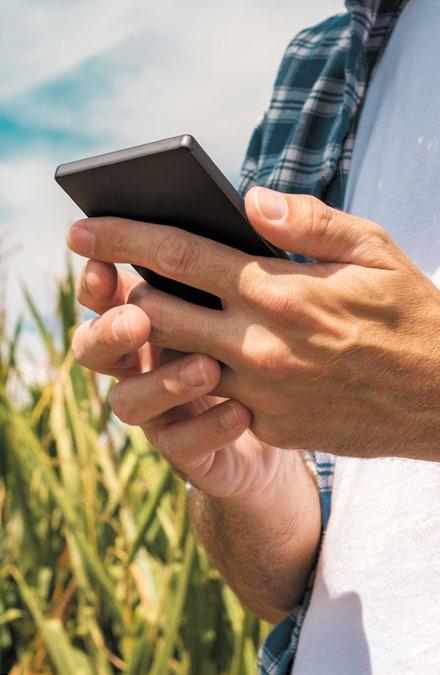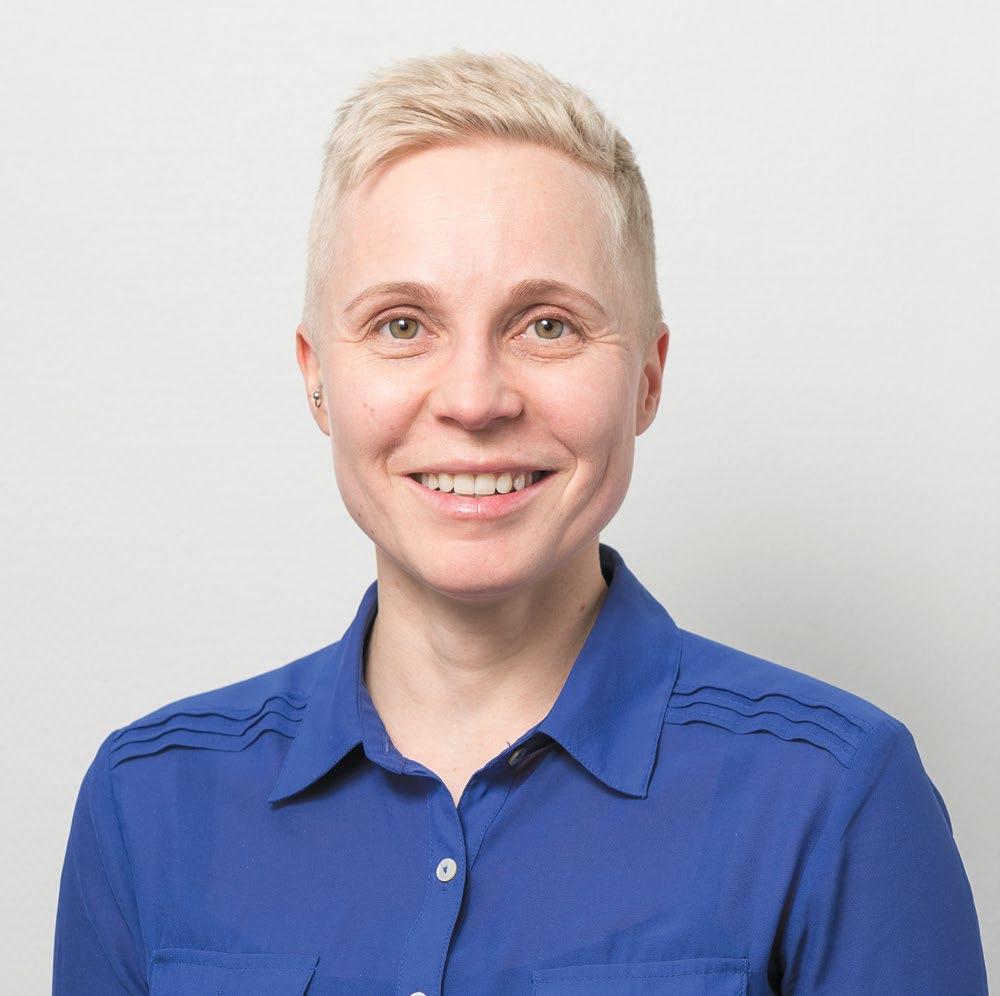
8 minute read
Map-based service shows the quantity and location of biomass
from Putting circular economy into practice
by Suomen ympäristökeskus - Finnish Environment Institute - Finlands miljöcentral
RECOVERY OF BIODEGRADABLE WASTE AND BY-PRODUCTS
Efficiency in nutrient recycling and biogas production
Text Tarja Sinervo
Circwaste project’s sub-project is driving a transition from the utilization of virgin nutrients to nutrient recycling in grain production. An open service called Biomass Atlas has also been developed in the project.
Tanks for liquid fertilizers were installed in the tractor-seed drill units, and the fertilizer was fed hydraulically to the ploughshare. Thanks to several fertilizer containers, it was possible to dispense multiple nutrients, such as nitrogen, phosphorus and potassium, separately from each other according to the needs of the plant.
Digital application on biomass
The project has also further developed a digital Biomass atlas application created by Luke. The map-based service illustrates biomasses that are nationally available, their volumes and location. This provides information on land use, forest resources, logging by-products, arable crop production and by-products, manure, and biodegradable waste and sludge from industry and municipalities. In the project, the application data has been further processed and combined with nutrient data. The Nutrient Calculator is a tool developed by Natural Resources Institute Finland and Finnish Environment Institute SYKE for the needs of regional nutrient planning.
The information is helpful when decision-makers are considering zoning, or a company is looking for a raw material, planning to set up a production facility, or thinking about where to place the processing residue. The map can be used to calculate the amount of biomass in a specific area on the map, or to view the restrictions on use and to model the effects of use on sustainable development. Part of the biomass is suitable as raw material for cosmetics, fiber, feed or nutrient preparations.
Separation of liquid slurry doubles the yield
Natural Resources Institute Finland has tested the separation method for pig slurry, i.e. settling, which separates the dregs at the bottom containing phosphorus and dry solid matter from the nitrogen-containing liquid on the top. This method can improve the energy production in a biogas plant, as the dregs at the bottom have a high phosphorus content and energy density compared to unseparated sludge. Therefore, it clearly has more methane-production potential than unseparated liquid slurry. According to Natural Resources Institute Finland’s calculations, a plant that processes the bottom sludge could produce 67% more methane and up to 99% more net energy.
Settling means also significant benefits in the fertilization of phosphorus-rich fields. The phosphorus limitation for environmental subsidy limits the amount of nitrogen that is applied with manure. The more soluble nitrogen and potassium we are able to spread and apply on fields, the less fertilizers se need. Natural Resources Institute Finland has estimated that a farm can save up to € 9,560 per year in the cost of fertilizer for 600 hectares of barley fields if the phosphorus fertility class of the fields is “good”.
The separation method can be commercialized if interested entrepreneurs come forward and seize the opportunity.
RECOVERY OF BIODEGRADABLE WASTE AND BY-PRODUCTS
Central Finland speeds up the production and use of biogas
For years, Central Finland has been investing in the use of biowaste. The Circwaste project has strengthened the build-up of a biogas ecosystem and encouraged to use biogas in transport.
Text Tarja Sinervo
The waste stream project in Central Finland has studied the biogas ecosystem composed of biodegradable waste and by–products processed in the region’s biogas plants, their recycling as well as the promotion of biogas production and use. – We have worked in our area for a long time on processing biodegradable waste and biogas, and the project has made it possible to further develop the topic. We are working to increase the production of biogas and its use in transport, says Development Manager Outi Pakarinen from the Regional Council of Central Finland. – Our study on the state of waste management in the region showed that a lot of biodegradable waste can, in fact, be found among mixed waste. Although we have had an obligation to collect biodegradable waste for twenty years already, in some places mixed waste contained almost 30 percent biodegradable waste. Collecting and processing it would mean that a lot of biogas could be used in transport.
The most important way to increase the bio–circular economy has been to develop cooperation and communication. – People need information that motivates them to sort waste carefully. In communication, co–operation with waste plants and municipalities is important. We have also carried out various studies and launched a network to involve all actors in the region’s production and supply chain in the ecosystem.
More use of biogas in transport
The use of biogas in transport has been increased, for example by encouraging municipalities to switch to biogas–driv
RECOVERY OF BIODEGRADABLE WASTE AND BY-PRODUCTS
Reducing food waste benefits everyone
Food waste is a costly issue for the society and everyone in the food system chain, from farmers to consumers. The Natural Resources Institute (Luke) investigated the causes and solutions for food waste, and the work will result in the first food waste roadmap for Finland, rather unique even on a European level.
Text Tarja Sinervo
The Natural Resources Institute (Luke) has started a pilot project, which will outline the first roadmap for food waste reduction in Southwest Finland. In addition, a nationwide roadmap for food waste will be prepared during the autumn.
A wide range of actors in the food system chain were brought together in three workshops in Southwest Finland. Representatives of primary production, the food industry, retail chains, waste management, meal services, food aid operators, the City of Turku and development companies were present. – In the first workshop, we mapped the problems causing food waste in the region. Sector–specific challenges included distribution channels for primary production, incorrect labeling, waste, food date labels, and unpredictable consumer behavior. There was a need for more information, as well as information on store locations, a data bank on food waste, packaging sensors and a number of other issues, says Juha–Matti Katajajuuri, specialist researcher at the Natural Resources Institute.
PHOTO: OWN PHOTO – Sorting biowaste and driving with a biogas engine are easy ways to promote circular economy, says Outi Pakarinen. She has been driving a biogas car for almost ten years.
en vehicles and by encouraging service providers to require gas–powered cars. For example, Jyväskylä’s home nursing staff is driving vehicles with biogas energies. During the project, the number of gas–powered vehicles in Central Finland has increased from 93 (Q2/2016) to 780 (Q2/2020).* – The use of biogas–driven buses has been investigated before, but no decisions were made. By participating in the European BiogasAction project through the Circwaste project, we had a chance to

do a study trip to Sweden in the autumn of 2018. We heard two cities’ experiences about biogas buses and received useful information, for example what the municipality must take into account when planning biogas buses. The experiences were encouraging, and a year ago four biogas buses started operating in Jyväskylä, Pakarinen says.
*SOURCE: TRAFICOM, STATISTICAL DATABASE (FIGURES INCLUDE CNG, PETROL/CNG AND DIESEL/CNG)
Other sub-projects for the recovery of biodegradable waste and by-products of the Circwaste project:
• The Turku University of Applied Sciences project investigates areas and actors suitable for biogas production. In addition, training will be provided to farmers, feasibility studies will be carried out for new biogas plants, and additional information will be collected to support procurement decisions for biogas plants. The aim is that at least one positive investment decision for the biogas plant will be made during the project, and preparations related to the construction of the plant will be started during the project. Further information: Pekka Alho, Project Manager, Turku University of Applied Sciences, firstname.surname @turkuamk.fi • The Natural Resources Centre’s subproject identifies and develops the most efficient logistics and warehousing practices for the distribution of surplus food. The project will study the functioning of food redistribution regulations and food labeling with authorities and other actors. In addition, efforts are being made to identify and resolve barriers to the utilization of surplus food. Another issue to be clarified in the subproject is whether lower quality products used as animal feed can be used for human consumption. Further information: Juha-Matti Katajajuuri, Senior scientist, Luonnonvarakeskus Luke, firstname.surname @luke.fi • The Natural Resources Center is exploring various techniques for reducing vegetable losses. The aim of the project is to create methods that minimize the by-products of vegetable processing and, on the other hand, utilize them, for example, as animal feed. The benefits of the further processing of byproducts are also being investigated. Further information: Juha-Matti Katajajuuri, Senior scientist, Luonnonvarakeskus Luke, firstname.surname@luke.fi
PHOTOS: GETTY IMAGES The development of forecasting systems, technology and intelligent solutions offer several business opportunities for companies.
Ways to minimize food waste
– The second and third workshops focused on finding solutions, which turned out to be not that easy at all. Some of the proposals addressed precise details, and there could be contradictions between initiatives. Individual actors and experts in the field were also interviewed for the national roadmap. – We outlined solutions for three different levels, the first of which is the social level. That means amendments to legislation, new types of incentives, voluntary agreements, taxation, subsidies and financial incentives. Voluntary commitments in the field and expanding them, as well as sensible guidance, would steer the development in the right direction, says Katajajuuri. – The second level concerns education and knowledge. In the curriculum, food loss should be highlighted more strongly. The same applies to secondary vocational schools, especially in chef training. New ways of sharing and targeting information are needed, for example a food material flow marketplace that shares information on the locations and volumes of waste. We need a common platform where the industry, experts, science and government can work together and come up with innovations in order to further minimize food loss. – The third level concerns guidance and policy development. The starting point is to help consumers and actors in the food chain to reduce food waste. This can be achieved by improving product placement and packaging, better understanding of consumers and influencing them, branding of food waste, and own product families, certificates and food waste restaurants. The development of forecasting systems, technology and intelligent solutions provide business opportunities for companies. Investment in research, food loss monitoring and updating the roadmap are also important measures. Cooperation between all parties in the chain as well as the public sector is very important, Katajajuuri reminds.
KUVA: OMA ARKISTO







